The Influence of Structural Design on the Electronic Properties of a Frisch Grid Cadmium Zinc Telluride Detector by a Finite Element Method
Abstract
1. Introduction
2. Method
2.1. Derivation of Electric Fields, Potentials and Weight Potential
2.2. Derivation of the Charge Induced Efficiency (CIE)Formula
2.3. Modelling of Detectors
3. Results and Discussion
3.1. Effect of Distance Between Frisch Grid and Anode on Detector Performance
3.2. Effect of Frisch Grid Area on Detector Performance
3.3. Effect of Relative Permittivity of Frisch Grid Material on Detector Performance
4. Discussion
Author Contributions
Funding
Data Availability Statement
Acknowledgments
Conflicts of Interest
References
- Sordo, S.D.; Abbene, L.; Caroli, E.; Mancini, A.M.; Zappettini, A.; Ubertini, P. Progress in the development of CdTe and CdZnTe semiconductor radiation detectors for astrophysical and medical applications. Sensors 2009, 9, 3491–3526. [Google Scholar] [CrossRef] [PubMed]
- Pennicard, D.; Pirard, B.; Tolbanov, O.; Iniewski, K. Semiconductor materials for X-ray detectors. MRS Bull. 2017, 42, 445–450. [Google Scholar] [CrossRef]
- Kasap, S.O.; Willoughby, A. Mercury Cadmium Telluride: Growth, Properties and Applications; John Wiley & Sons: Hoboken, NJ, USA, 2011. [Google Scholar]
- Eisen, Y.; Shor, A. CdTe and CdZnTe materials for room-temperature X-ray and gamma ray detectors. J. Cryst. Growth 1998, 184, 1302–1312. [Google Scholar] [CrossRef]
- Myronakis, M.E.; Zvelebil, M.; Darambara, D.G. Pixelated CdZnTe for imaging in medicine: Overall performance assessment using an advanced computational modeling framework. In Proceedings of the 2012 IEEE Nuclear Science Symposium and Medical Imaging Conference Record, Anaheim, CA, USA, 29 October–3 November 2012; IEEE: New York, NY, USA, 2012; pp. 4276–4277. [Google Scholar]
- Iniewski, K. CZT detector technology for medical imaging. J. Instrum. 2014, 9, C11001. [Google Scholar] [CrossRef]
- Roy, U.N.; Camarda, G.S.; Cui, Y.; James, R.B. High-resolution virtual Frisch grid gamma-ray detectors based on as-grown CdZnTeSe with reduced defects. Appl. Phys. Lett. 2019, 114, 232107. [Google Scholar] [CrossRef]
- Bolotnikov, A.E.; Camarda, G.S.; Carini, G.A.; Wright, G.W.; McGregor, D.S.; McNeil, W.; James, R.B. New results from performance studies of Frisch-grid CdZnTe detectors. In Hard X-Ray and Gamma-Ray Detector Physics VI; SPIE: Bellingham, WA, USA, 2004; pp. 33–45. [Google Scholar]
- Limousin, O. New trends in CdTe and CdZnTe detectors for X-and gamma-ray applications. Nucl. Instrum. Methods Phys. Res. Sect. A Accel. Spectrometers Detect. Assoc. Equip. 2003, 504, 24–37. [Google Scholar] [CrossRef]
- Sze, S.M. Semiconductor Devices: Physics and Technology; John Wiley & Sons: Hoboken, NJ, USA, 2008. [Google Scholar]
- Prettyman, T. Method for mapping charge pulses in semiconductor radiation detectors. Nucl. Instrum. Methods Phys. Res. Sect. A Accel. Spectrometers Detect. Assoc. Equip. 1999, 422, 232–237. [Google Scholar] [CrossRef]
- Makeev, A.; McGrath, J.; Clajus, M.; Snyder, S.; Glick, S.J. Achieving sub-pixel resolution using CZT-based photon counting detectors for dedicated breast CT. In Medical Imaging 2013: Physics of Medical Imaging; SPIE: Bellingham, WA, USA, 2013; pp. 211–218. [Google Scholar]
- He, Z. Review of the Shockley–Ramo theorem and its application in semiconductor gamma-ray detectors. Nucl. Instrum. Methods Phys. Res. Sect. A Accel. Spectrometers Detect. Assoc. Equip. 2001, 463, 250–267. [Google Scholar] [CrossRef]
- Makeev, A.; Rodrigues, M.; Wang, G.-C.; Glick, S.J. Modeling CZT/CdTe X-ray photon-counting detectors. In Medical Imaging 2015: Physics of Medical Imaging; SPIE: Bellingham, WA, USA, 2015. [Google Scholar]
- Myronakis, M.E.; Darambara, D.G. Monte Carlo investigation of charge-transport effects on energy resolution and detection efficiency of pixelated CZT detectors for SPECT/PET applications. Med. Phys. 2011, 38, 455–467. [Google Scholar] [CrossRef]
- McGregor, D.; He, Z.; Seifert, H.; Rojeski, R.; Wehe, D. CdZnTe semiconductor parallel strip Frisch grid radiation detectors. IEEE Trans. Nucl. Sci. 1998, 45, 443–449. [Google Scholar] [CrossRef]
- Luke, P. Unipolar charge sensing with coplanar electrodes-application to semiconductor detectors. IEEE Trans. Nucl. Sci. 1995, 42, 207–213. [Google Scholar] [CrossRef]
- Nakhostin, M. Signal Processing for Radiation Detectors; John Wiley & Sons: Hoboken, NJ, USA, 2017. [Google Scholar]
- Charpak, G.; Sauli, F. High-resolution electronic particle detectors. In Experimental Techniques in High-Energy Nuclear and Particle Physics; Ferbel, T., Ed.; World Scientific Publishing Co., Pte. Ltd: Singapore, 1991. [Google Scholar]
- Siewerdsen, J.H.; Antonuk, L.E.; El-Mohri, Y.; Yorkston, J.; Huang, W.; Cunningham, I.A. Signal, noise power spectrum, and detective quantum efficiency of indirect-detection flat-panel imagers for diagnostic radiology. Med. Phys. 1998, 25, 614–628. [Google Scholar] [CrossRef] [PubMed]
- Radeka, V. Low-noise techniques in Detectors. Annu. Rev. Nucl. Part. Sci. 1988, 38, 217–277. [Google Scholar] [CrossRef]
- Garrett, H.B.; Whittlesey, A.C. Guide to Mitigating Spacecraft Charging Effects; John Wiley & Sons: Hoboken, NJ, USA, 2012. [Google Scholar]
- Al-Adili, A.; Hambsch, F.J.; Bencardino, R.; Pomp, S.; Oberstedt, S.; Zeynalov, S. On the Frisch–Grid signal in ionization chambers. Nucl. Instrum. Methods Phys. Res. Sect. A Accel. Spectrometers Detect. Assoc. Equip. 2012, 671, 103–107. [Google Scholar] [CrossRef]
- Hötzl, H.; Winkler, R. Experiences with large-area frisch grid chambers in low-level alpha spectrometry. Nucl. Instrum. Methods Phys. Res. 1984, 223, 290–294. [Google Scholar] [CrossRef]
- Kolstein, M.; Ariño, G.; Chmeissani, M.; De Lorenzo, G. Simulation of charge transport in pixelated CdTe. J. Instrum. 2014, 9, C12027. [Google Scholar] [CrossRef] [PubMed]
- Polack, J.; Hirt, M.; Sturgess, J.; Sferrazza, N.; Bolotnikov, A.; Babalola, S.; Camarda, G.; Cui, Y.; Egarievwe, S.; Fochuk, P. Variation of electric shielding on virtual Frisch-grid detectors. Nucl. Instrum. Methods Phys. Res. Sect. A Accel. Spectrometers Detect. Assoc. Equip. 2010, 621, 424–430. [Google Scholar] [CrossRef]
- Bolotnikov, A.E.; Ackley, K.; Camarda, G.S.; Cherches, C.; Cui, Y.; De Geronimo, G.; Fried, J.; Hodges, D.; Hossain, A.; Lee, W.; et al. An array of virtual Frisch-grid CdZnTe detectors and a front-end application-specific integrated circuit for large-area position-sensitive gamma-ray cameras. Rev. Sci. Instrum. 2015, 86, 073114. [Google Scholar] [CrossRef] [PubMed]
- Cui, Y.; Bolotnikov, A.; Camarda, G.; Hossain, A.; Yang, G.; James, R. CZT virtual Frisch-grid detector: Principles and applications. In Proceedings of the 2009 IEEE Long Island Systems, Applications and Technology Conference, Farmingdale, NY, USA, 1 May 2009; IEEE: New York, NY, USA, 2009; pp. 1–5. [Google Scholar]
- Uram, J.D.; Ke, K.; Mayer, M. Noise and bandwidth of current recordings from submicrometer pores and nanopores. ACS Nano 2008, 2, 857–872. [Google Scholar] [CrossRef] [PubMed]
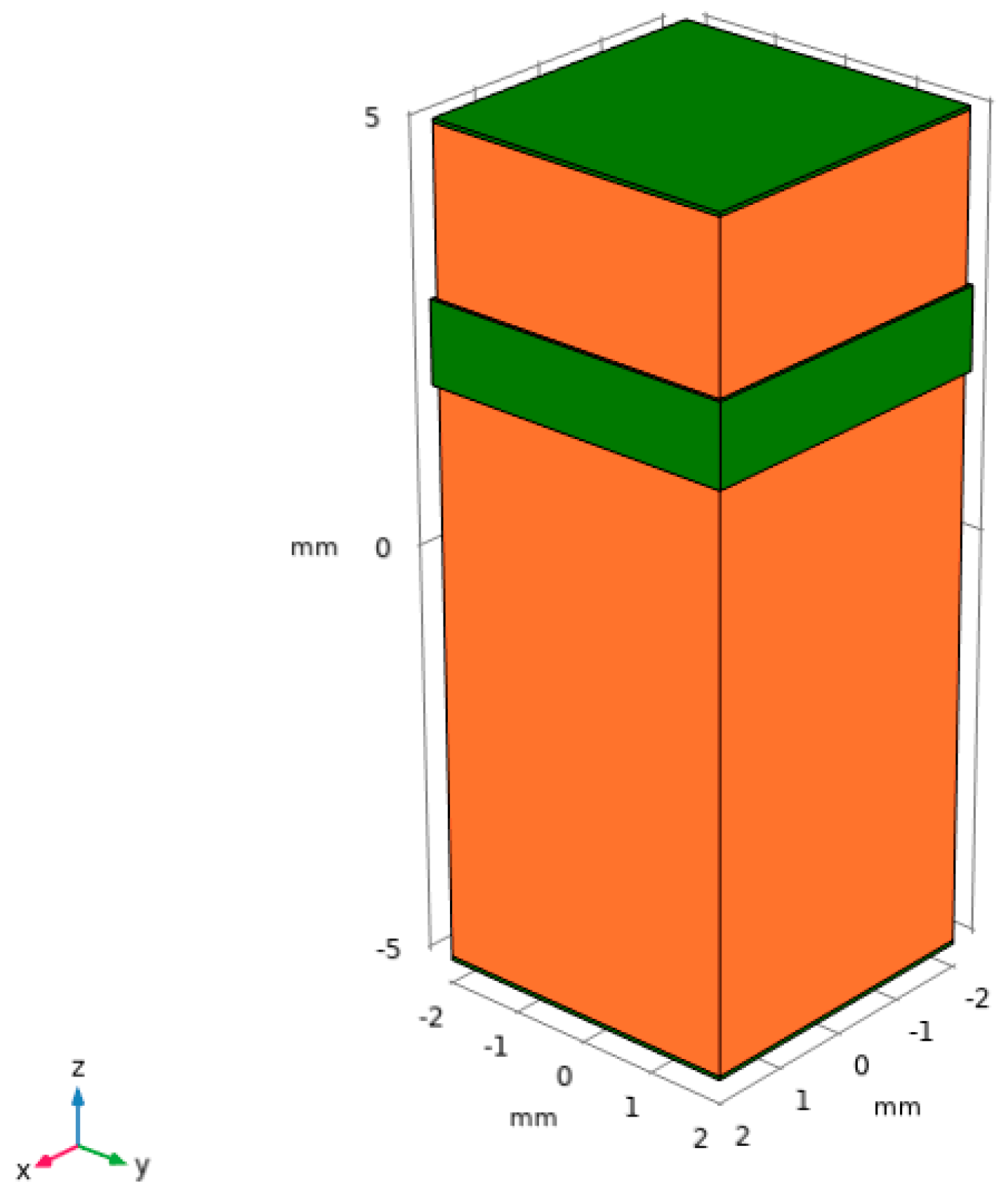
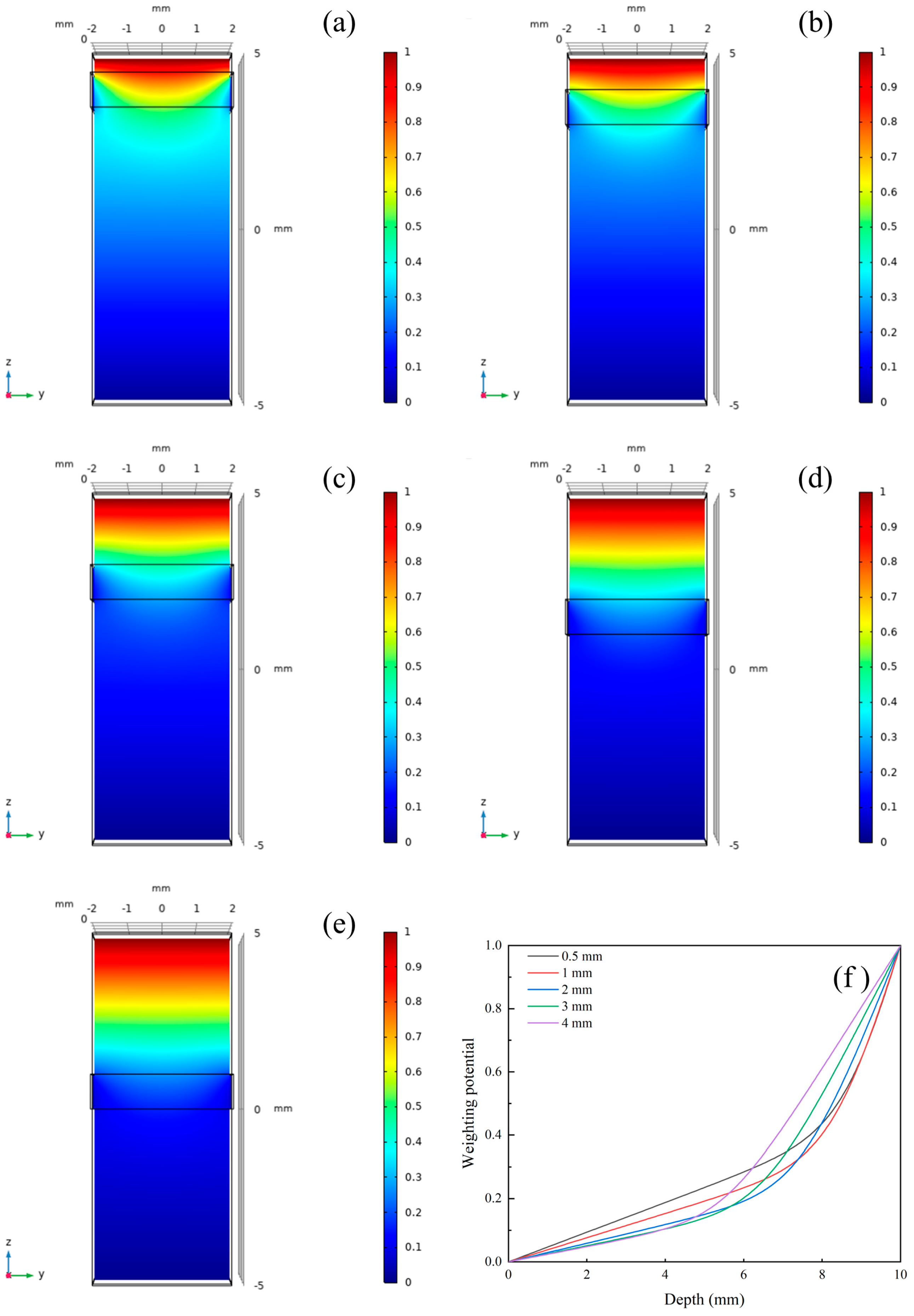
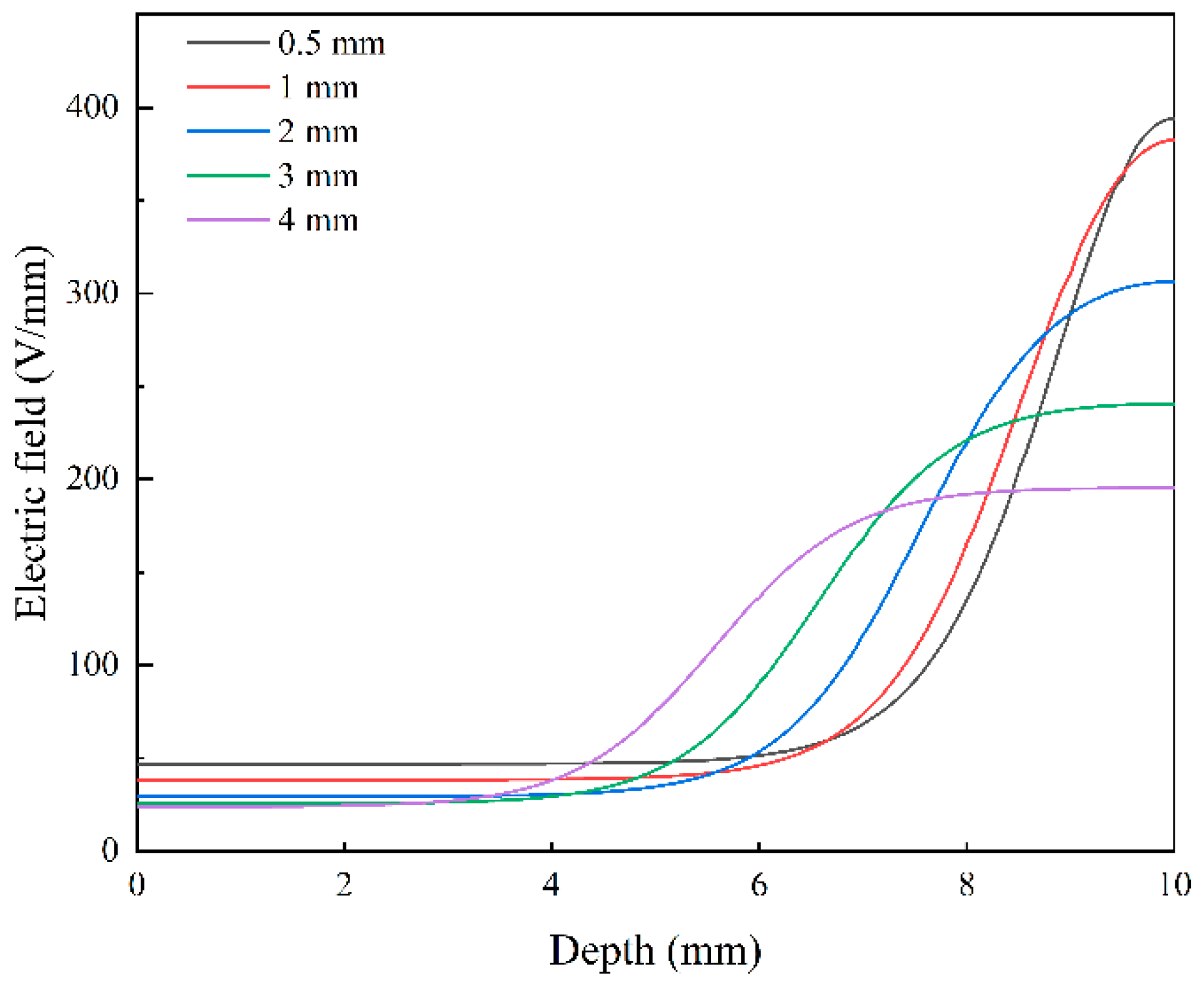

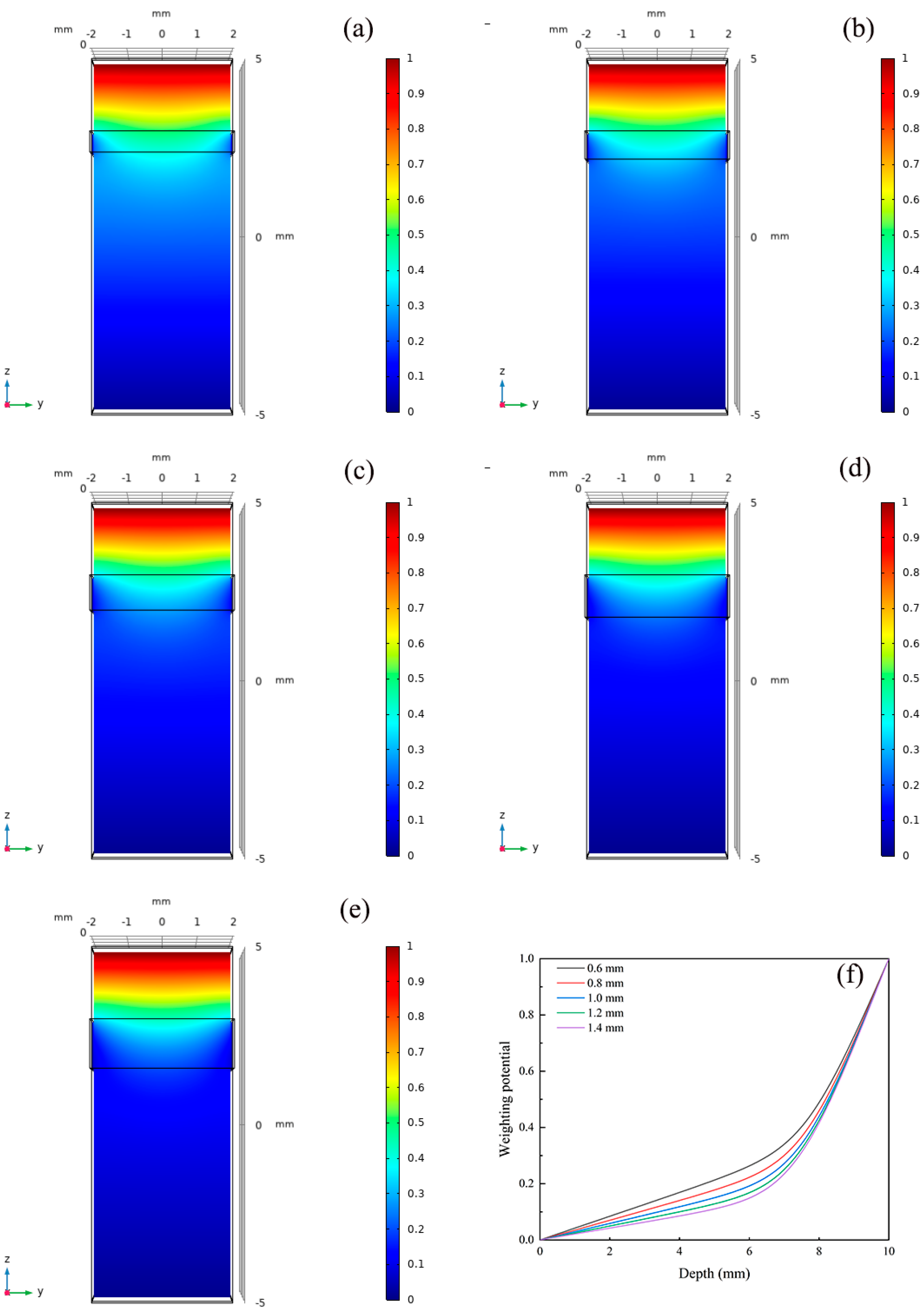
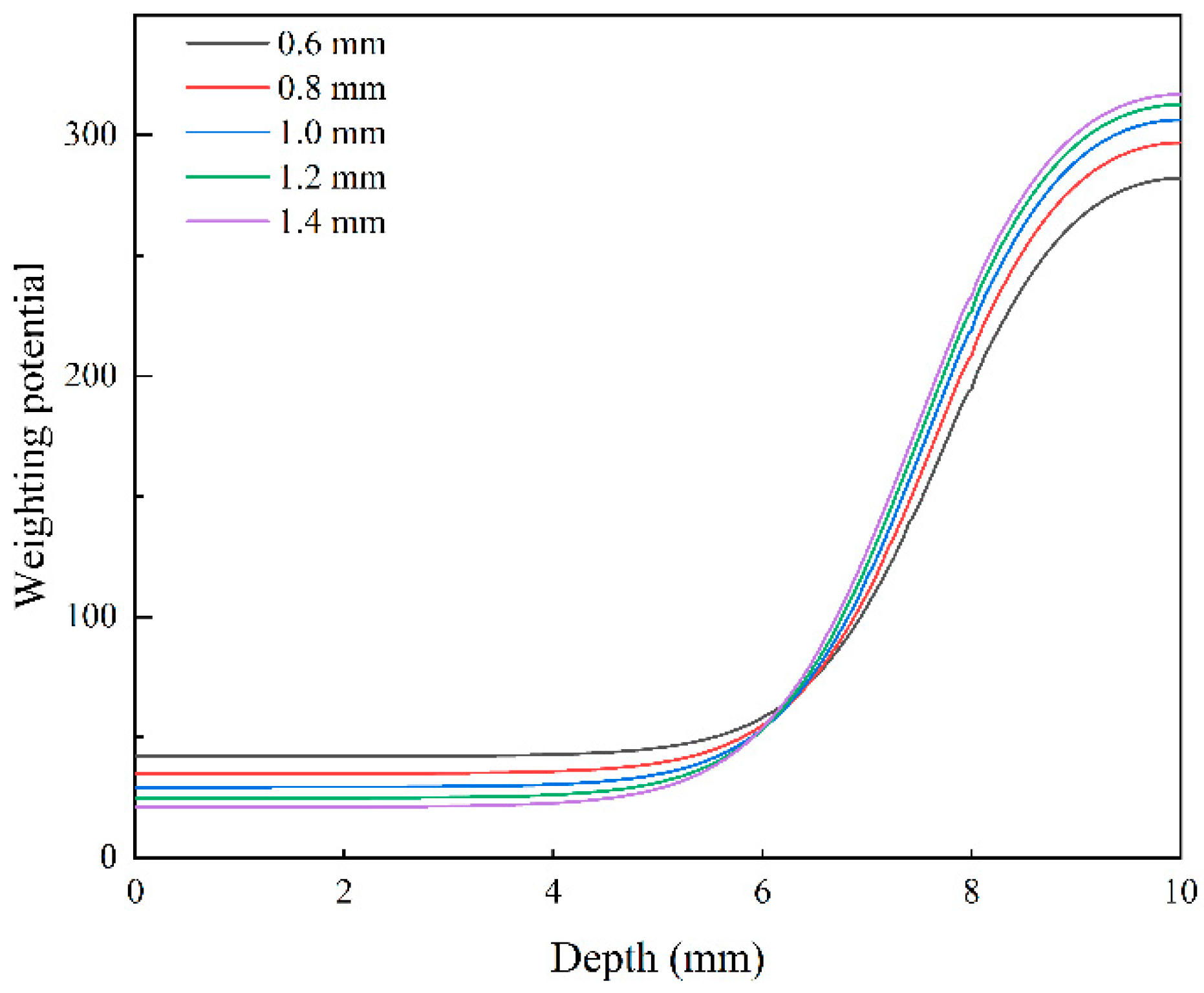
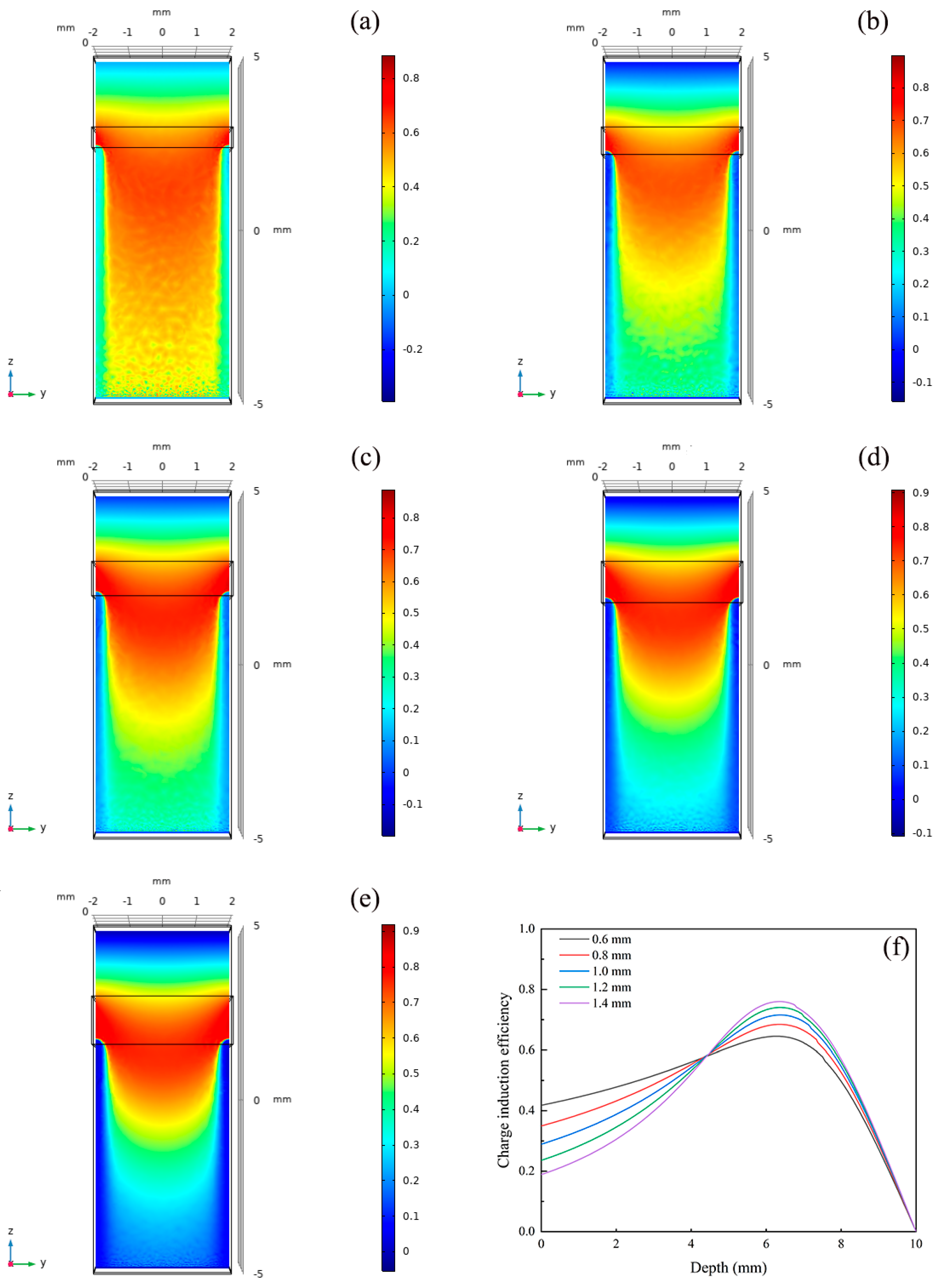
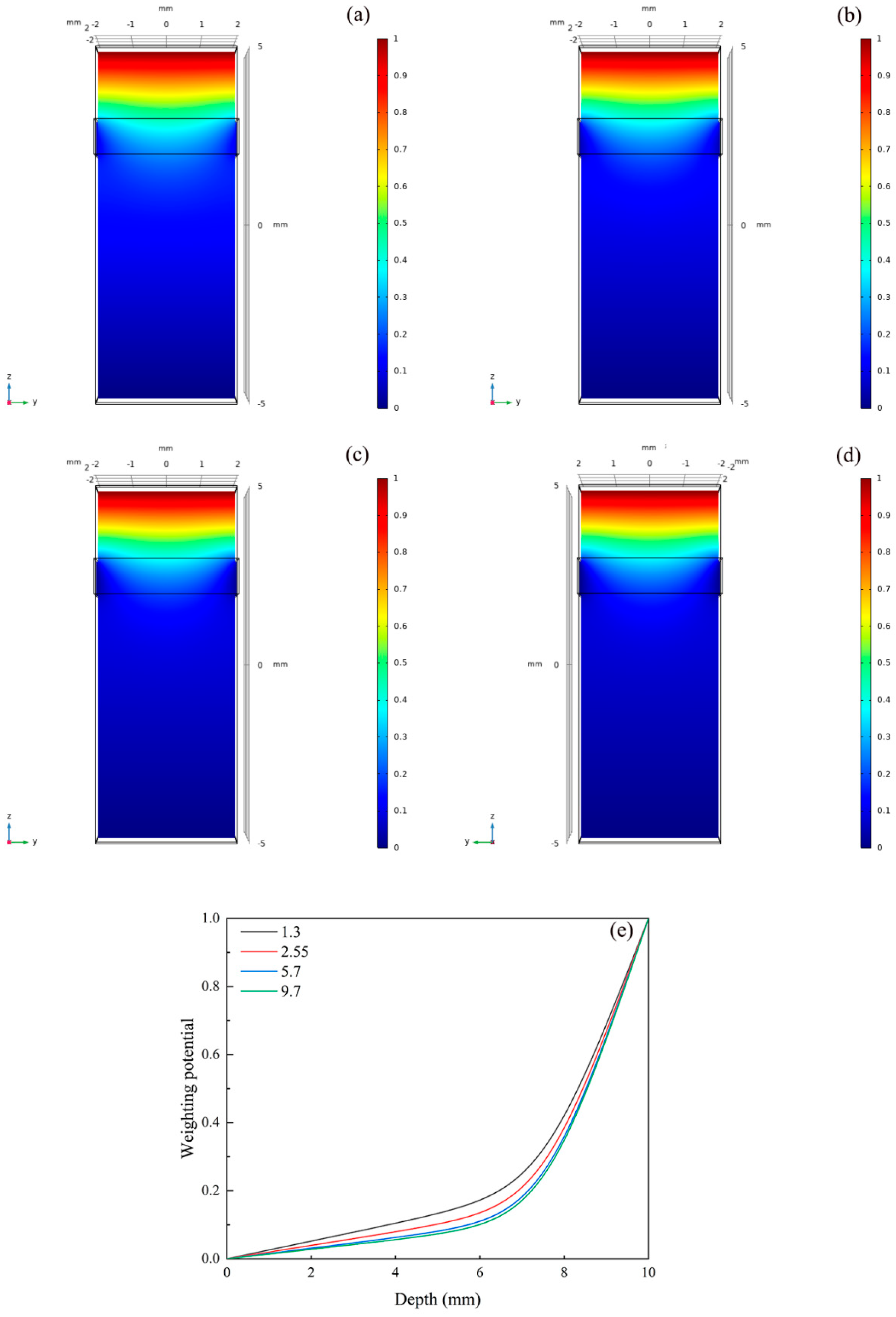
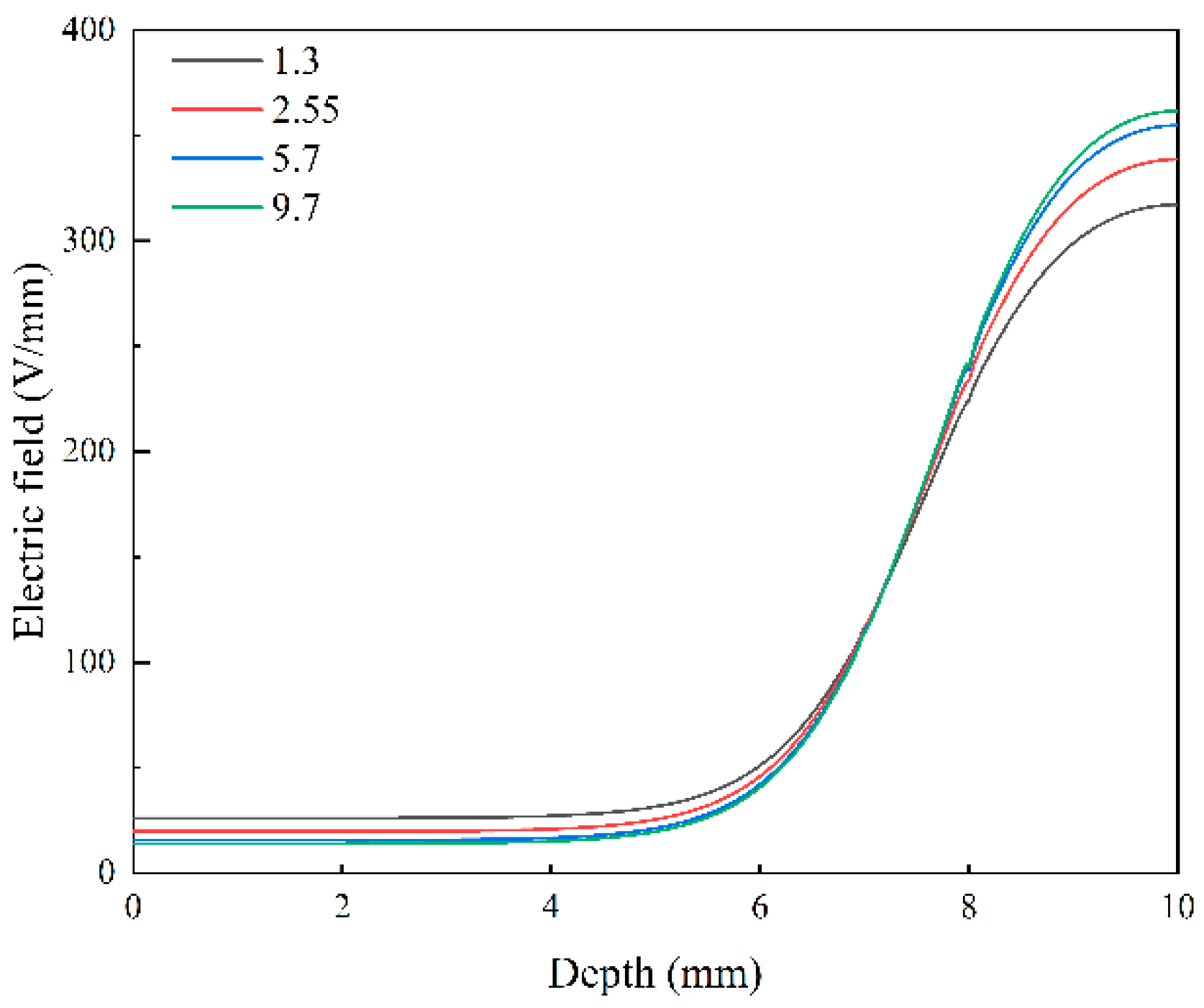
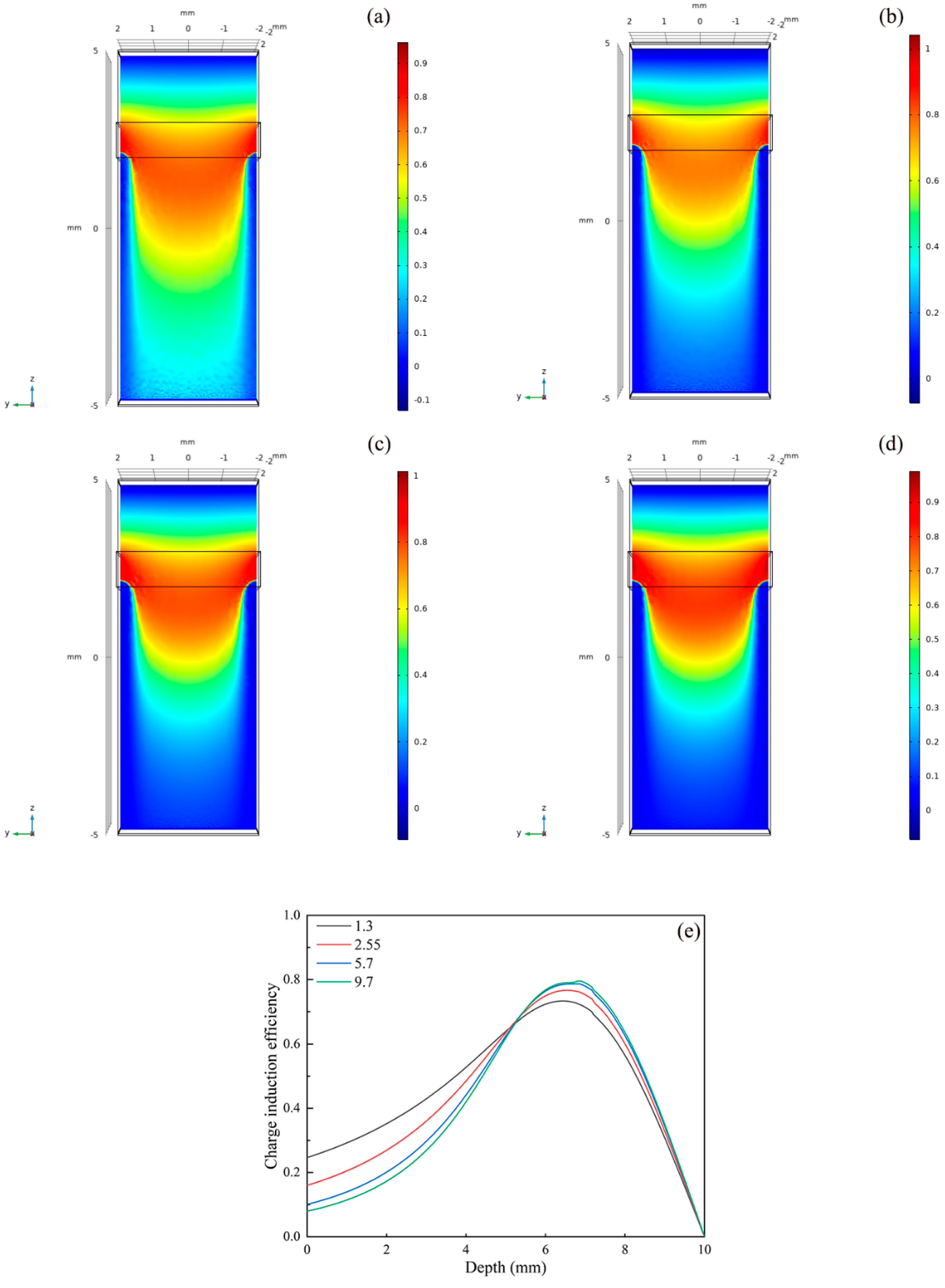
Disclaimer/Publisher’s Note: The statements, opinions and data contained in all publications are solely those of the individual author(s) and contributor(s) and not of MDPI and/or the editor(s). MDPI and/or the editor(s) disclaim responsibility for any injury to people or property resulting from any ideas, methods, instructions or products referred to in the content. |
© 2025 by the authors. Licensee MDPI, Basel, Switzerland. This article is an open access article distributed under the terms and conditions of the Creative Commons Attribution (CC BY) license (https://creativecommons.org/licenses/by/4.0/).
Share and Cite
Zhang, Z.; Li, Y.; Cao, M.; He, W.; Xu, Z.; Huang, J.; Wang, L. The Influence of Structural Design on the Electronic Properties of a Frisch Grid Cadmium Zinc Telluride Detector by a Finite Element Method. Crystals 2025, 15, 361. https://doi.org/10.3390/cryst15040361
Zhang Z, Li Y, Cao M, He W, Xu Z, Huang J, Wang L. The Influence of Structural Design on the Electronic Properties of a Frisch Grid Cadmium Zinc Telluride Detector by a Finite Element Method. Crystals. 2025; 15(4):361. https://doi.org/10.3390/cryst15040361
Chicago/Turabian StyleZhang, Zhenzhao, Yu Li, Meng Cao, Weifan He, Zhen Xu, Jian Huang, and Linjun Wang. 2025. "The Influence of Structural Design on the Electronic Properties of a Frisch Grid Cadmium Zinc Telluride Detector by a Finite Element Method" Crystals 15, no. 4: 361. https://doi.org/10.3390/cryst15040361
APA StyleZhang, Z., Li, Y., Cao, M., He, W., Xu, Z., Huang, J., & Wang, L. (2025). The Influence of Structural Design on the Electronic Properties of a Frisch Grid Cadmium Zinc Telluride Detector by a Finite Element Method. Crystals, 15(4), 361. https://doi.org/10.3390/cryst15040361




